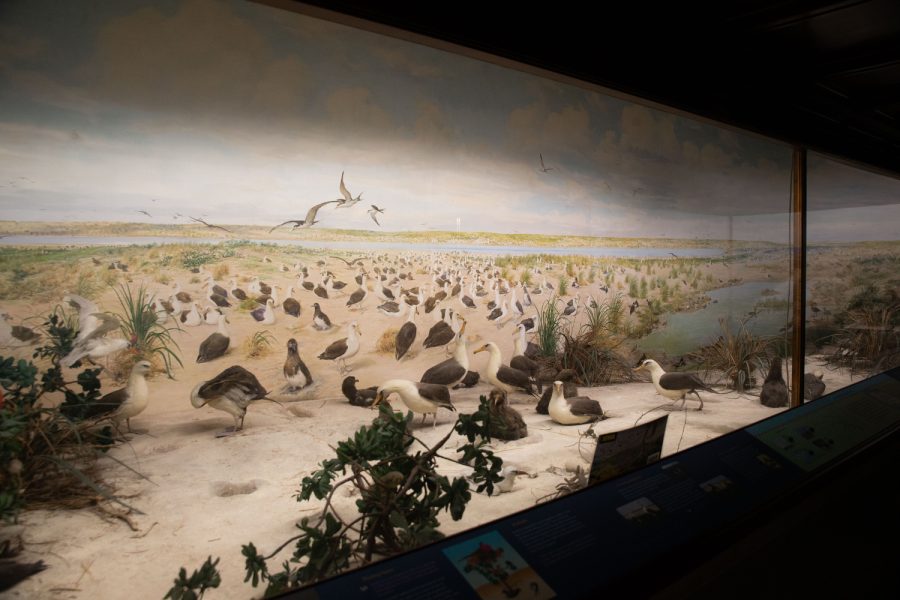UI’s Laysan Island Cyclorama is in need of repairs after 100 years of operation
The cyclorama, which offers guests a view of what the Laysan Island used to look like is part of the Museum of Natural History in MacBride Hall.
Laysan Island Cyclorama is seen at Macbride Hall on March 23, 2023. As a collection of the University of Iowa Museum of Natural History, the cyclorama replicates the avian population and scenery of the Hawaiian island, Laysan before the 1910s.
April 4, 2023
Officials from the University of Iowa’s Museum of Natural History are trying to raise $1 million to pay for the restoration of an exhibit in the Hall of Birds after over 100 years of operation.
The Laysan Island Cyclorama exhibit needs a heating, ventilation, and air conditioning system and professional conservators to restore the mural and foreground included in the cyclorama.
The UI is home to one of few cycloramas in the world and the first to focus on a single ecosystem. The cyclorama is a 360-degree exhibit located in the museum’s Hall of Birds.
First open to the public in 1914, the exhibit holds specimens from Laysan Island, one of the largest single landmasses located in the Northwestern Hawaiian Islands. The cyclorama tells the story of human interaction in the environment.
Former UI Museum director Charles Nutting set out on an expedition in 1902 to Northwestern Hawaii, where he found Laysan Island. He wanted to bring his findings back with him to Iowa, so he sent a team back to the island in 1911 to bring back bird specimens, eggs, plant material, and anything else they could.
By the time the team returned, the Laysan Island ecosystem was destroyed because of Japanese feather poachers and invasive rabbits.
Instead, the director decided to create a cyclorama to preserve what the ecosystem once looked like.
Although it’s sealed off from human interaction unlike the island, the cyclorama has taken on natural wear and tear from extreme weather changes, light deterioration, and dust build-up.
Jessica Smith, communications coordinator at the UI Pentacrest Museums, said the exhibit is a cautionary tale.
“There are a number of concerns that conservators have about making sure that we can preserve the cyclorama to be available and safe for future generations because it is so important,” Smith said.
She said there are long-term and short-term goals for restoring the cyclorama.
“The short-term goals are fundraising,” she said. “After that, installing a heating, ventilation, and air conditioning system would be at the top of the list.”
Samuel Hudziak, a doctoral candidate in the UI Department of Earth and Environmental Sciences, said the cyclorama is a unique resource in an email to The Daily Iowan.
“As is often the case with island ecosystems, human involvement has negatively impacted local populations with the introduction of non-native predators, and in more recent history, trash washing up on shores posing significant health risks to local birds,” Hudziak wrote.
Hudziak wrote that he thinks resources are appropriate to update and restore the exhibit.
“Our department utilizes the Museum as a teaching aid, and I think getting students out of the traditional classroom environment to engage with materials in different and new ways is a powerful teaching technique that strengthens students’ understanding and connection to the materials,” he wrote.
RELATED: Regents approve $4.7 million Burge Residence Hall renovations
Within the last five years, the museum has become part of the International Panoramic Council. According to its website, the council’s goal is to promote professional trusteeship and to stimulate worldwide research and communication on panoramas and cycloramas both modern and historic. That means saving and preserving the few surviving panoramas and their buildings.
UI Pentacrest Museums Director Liz Crooks serves as part of the council and has spoken at conferences all around the world. This upcoming fall, the yearly International Panorama Conference is coming to MacBride Hall at the UI.
First-year student Sophia Heim said as an environmental science major, she favors anything that supports the environment.
“It’s definitely an important thing for Iowa to keep,” she said. “[Climate change] is a hot topic, and it’s something that can help educate people on the issues.”
The Laysan Island Cyclorama was also a part of One Day For Iowa this year to fundraise the efforts to restore the exhibit. The museum had a donor willing to match every donation made to the fund and exceeded its $2,000 match goal, Smith said.
The cyclorama restoration fund has raised a total of $309,119, as of April 3.
“Overall, the Museum of Natural History saw a record number of gifts and engagement during the day of online giving,” Smith said. “Museum staff are touched and inspired by the commitment from our campus and community.”



